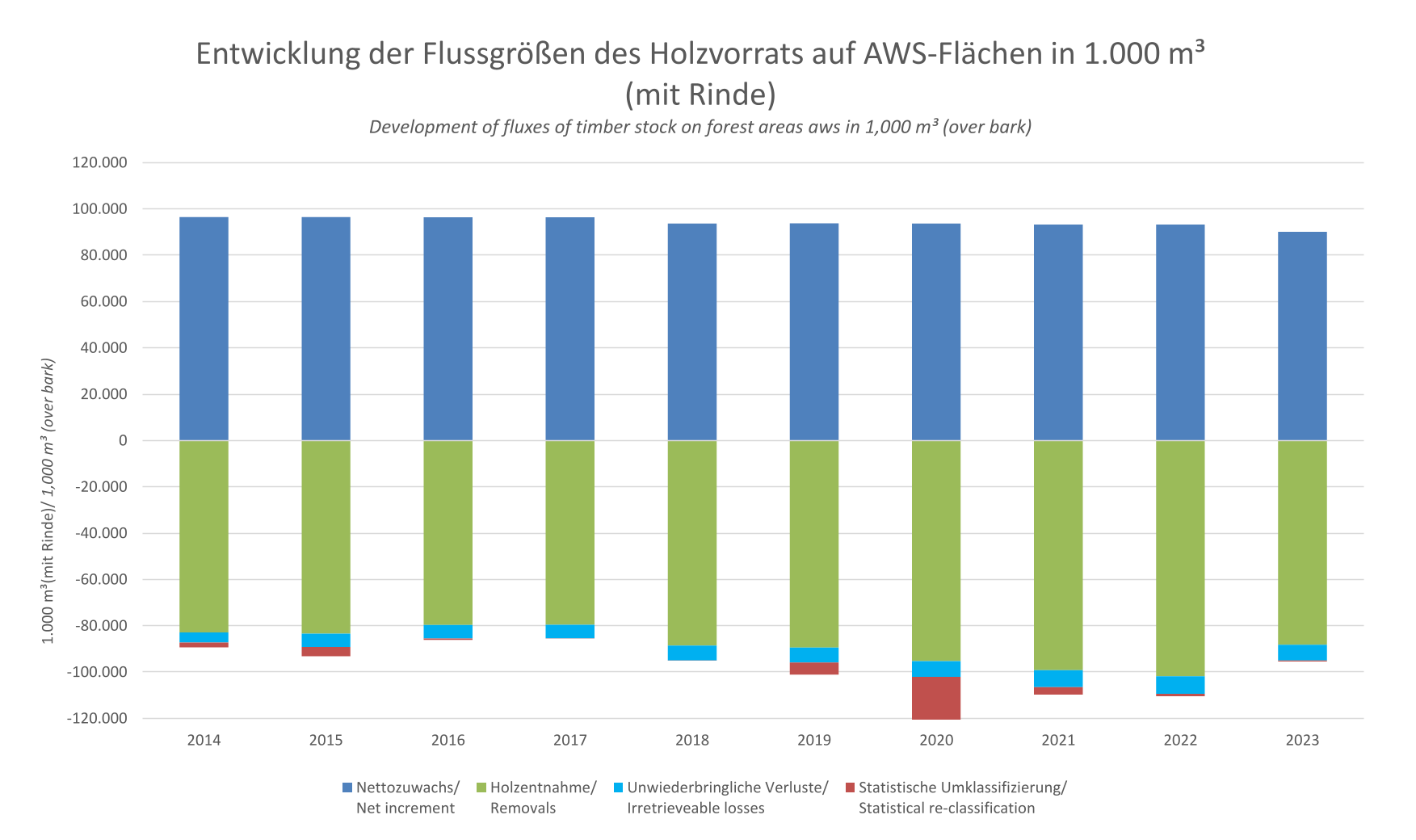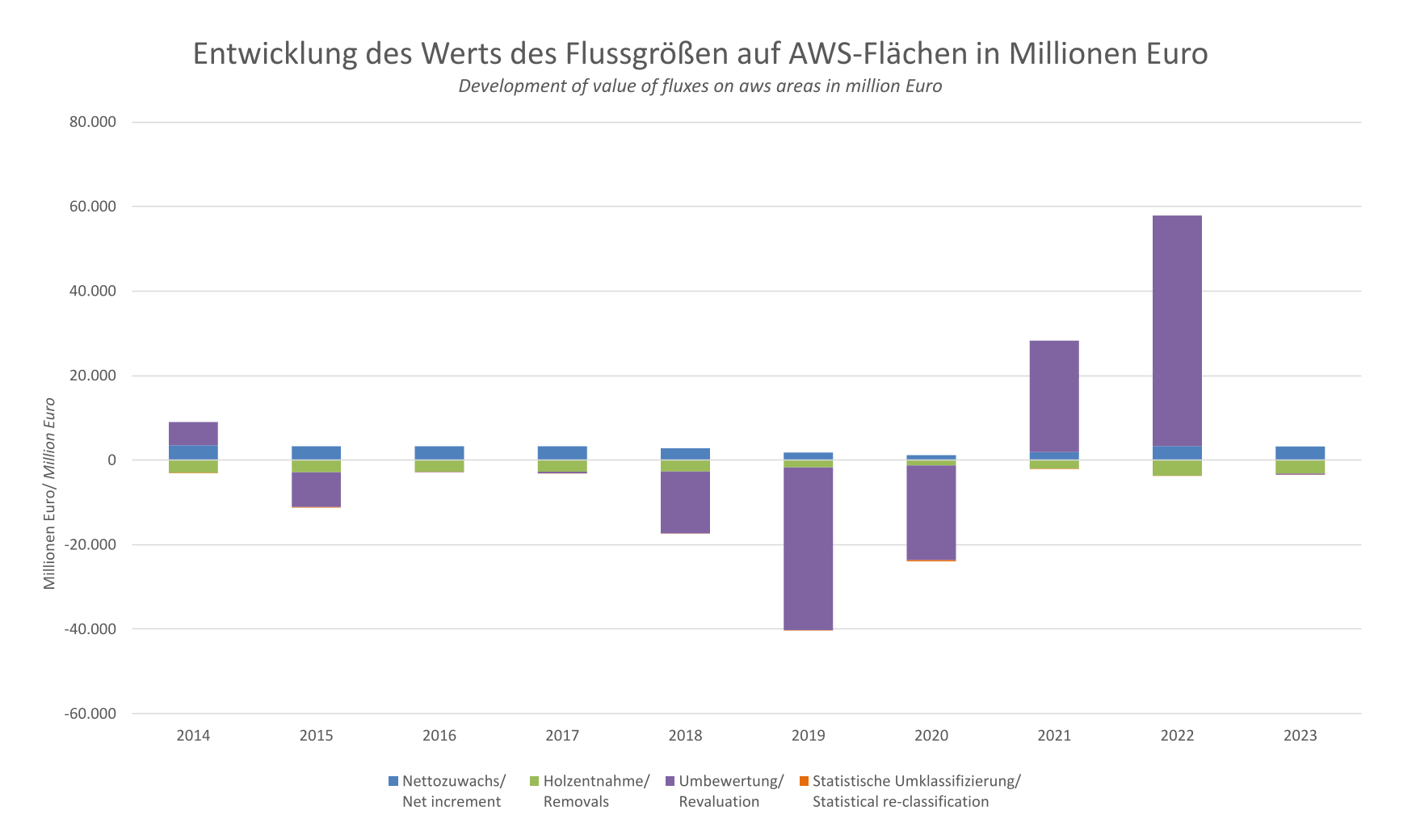EFA-table A 2a shows the changes in timber stock in the respective reporting year. For each forest area category, the net increment is added as an input to the initial stock of standing timber. Outflows are removals and irretrievable losses. The position irretrievable losses includes all other reductions of the timber stock that were not recorded under the position removals. This includes, e.g., unused lumber from end-uses and thinning measures as well as unused quantities of timber due to windthrow and other disasters (e.g. forest fires).
Statistical reclassification is caused by the transition of forest area available for wood supply (forest area AWS) to forest area not available for wood supply (forest area NAWS). The physical timber stock balance refers to the forest area identified in the physical forest area balance.
Complementary to the value of forest area depicted in EFA-table A 1b, EFA-table A 2b shows the monetary evaluation of the timber stock on the area categories forest area AWS and other land with tree cover available for wood supply.
Publications
- Seintsch B, Englert H, Dieter M (2020) Kalamitäten führen zu forstlichem "Rekordergebnis" : Ergebnisse der Forstwirtschaftlichen Gesamtrechnung 2018: Großer Produktionswert und hoher Unternehmensgewinn. Holz Zentralbl 146(27):506-507 PDF Dokument (nicht barrierefrei) 1884 KB
- Rosenkranz L, Englert H, Seintsch B (2019) European forest accounts for Germany - Quality of data bases and accounting methods. Allg Forst Jagdzeitg 190(1-2):31-52
- Rosenkranz L, Englert H, Seintsch B (2018) Die Bewertung des Holzvorrats in der Waldgesamtrechnung. AFZ Wald 73(23):11-13
PDF Document - Rosenkranz L, Englert H, Jochem D, Seintsch B (2018) Methodenbeschreibung zum Tabellenrahmen der European Forest Accounts und Ergebnisse der Jahre 2014 und 2015: Abschlussbericht Teilprojekt 3. 2. revidierte Fassung. Braunschweig: Thünen-Institut, 86 p
PDF Document
Methodology
Physical timber stock balance
The basis for the physical timber stock balance is the timber stock data of the National Forest Inventory (BWI 2012). In the BWI, however, only the supply for the accessible, productive forest is listed. Information on the timber stock of non-accessible forest areas (= subcomponent of the forest area NAWS) is not available. Therefore, it is assumed that the forest area NAWS has the same average timber stock per hectare as the accessible, productive forest.
The net increment is defined as the gross increment less mortality. The data base for the calculation of the gross increment is the respective current five-year period of the baseline scenario of the forest development and timber resource modelling (WEHAM 2012). For calculating the net increment per hectare the BWI 2012 is used. It shows the annual average quantities of wood removal by type of withdrawal (here: utilization, unused, died-off) from the years 2002 to 2012. According to BWI 2012, around 90 % of wood removals fall under the category "used" whereas around 10 % is assigned to the categories "unused" or "died-off". It is assumed that the factor "share of use of the total removal" (= 90 %) can be also transferred to the current use of timber in the forest. The net increment per hectare is then calculated by multiplying the gross increment per hectare derived from WEHAM with the share of use of the total removal derived from BWI 2012.
The net increment is further multiplied with the timber stock of EFA-table A 1a and the ratio of the wood ground area of the accessible forest to the forest area of the accessible forest at the time of BWI 2012. In order to report the annual development of timber removals and irretrievable losses, the recalculation of fellings of the Thünen-Institute is used.
In regard to the statistical reclassification, it is assumed that land access to forest area NAWS will only when forest area AWS is set-aside for nature protection purposes. It is also assumed that the average timber stock on forest area NAWS equals the timber stock on forest area AWS.
Monetary timber stock balance
The monetary valuation of the timber stock is done only for forest area AWS. Timber stock on the forest area NAWS as well as the irretrievable losses are rated with 0 Euro per m³ over bark. This approach is based on the assumption that this part of the timber stock will not be economically utilized. The timber stock is valued with the annual average timber revenue less harvesting costs (roadside pick-up price) in Euro/m³ over bark across all assortments including energy wood, for the current reporting year. The average annual timber revenues for the tree species groups oak, beech, pine and spruce as well as the average timber harvesting costs for all tree species groups can be taken from the German Forest Accountancy Network of the BMEL. In this calculation, it is assumed that the standing timber stock has the same assortment structure as the removed timber stock. Therefore the not yet mature part of standing timber stock is overestimated by this assumption.
Contact person - staff member
Dr. Lydia Rosenkranz

Institute of Forestry
Leuschnerstraße 9121031 Hamburg-Bergedorf
- Telephone
- +49 531 2570 1707
- lydia.rosenkranz@thuenen.de
Scientist












